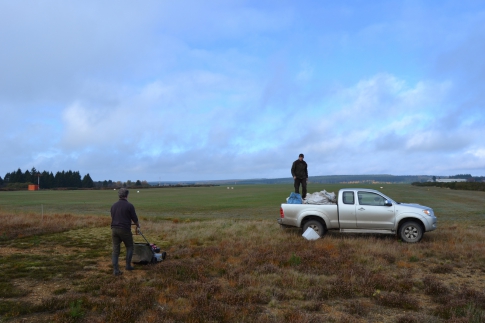News
2015-10-30
Restoring heathland: common heather seeds harvesting and sowing
Under the high voltage line connecting Nassogne to Tenneville, in the Natura 2000 site of Wamme-Masblette (BE34029), our LIFE Elia-RTE project had carried out in autumn 2013 a soil removing (surface layer), and swathed the soil on both sides of the corridor. These two swaths were planted during spring 2015 with forest edges species.

The central part of the corridor was dedicated to the restoration of a heather moor, still present on the nearby embankment of the Wamme river. This vegetation is the typical Natura 2000 habitat vegetation of wet heathlands (Code 4010). The team carried out a number of operations in order to boost this operation.
Seeds harvesting
Ends of runways from airfields of the Civil Aviation of Saint-Hubert, distant less than 6 km from the LIFE site, are densely occupied by common heather in very good conservation status. The extremely flat surface without rocks or stumps makes it possible to harvest with a light material.

A test with a simple lawn-mower and harvesting tank has proved to be very effective. Mowing the upper part of these common heathers leaves the basis undamaged for the regrowth of the plant next spring.

The material from shearing and harvested in the recovery tank was then filled into big bags to make it easy for transport to the sowing site.
An area of approximately 25 acres could be land-mowed in less than 4 hours.

Sowing on site
26 bachelor students in "Forest and Nature" orientation from Condorcet HEPH-Ath high school visiting the region of Saint-Hubert, gave a hand for the sowing operation.

After a briefing on the LIFE program and on achievements on the Saint-Hubert plateau, firstly through the LIFE Peatlands (2003-2007) and now the LIFE Elia, they set to work.
Hampers, buckets and jute bags have helped spread the harvested common heather mass.

They were able to sow on the entire surface (about 1 ha).


This test restore heather moorland, by local seed collection and sowing right after should probably give first indications of its effectiveness next spring.
If successful, we would replicate this technique on other sites using the same process.

